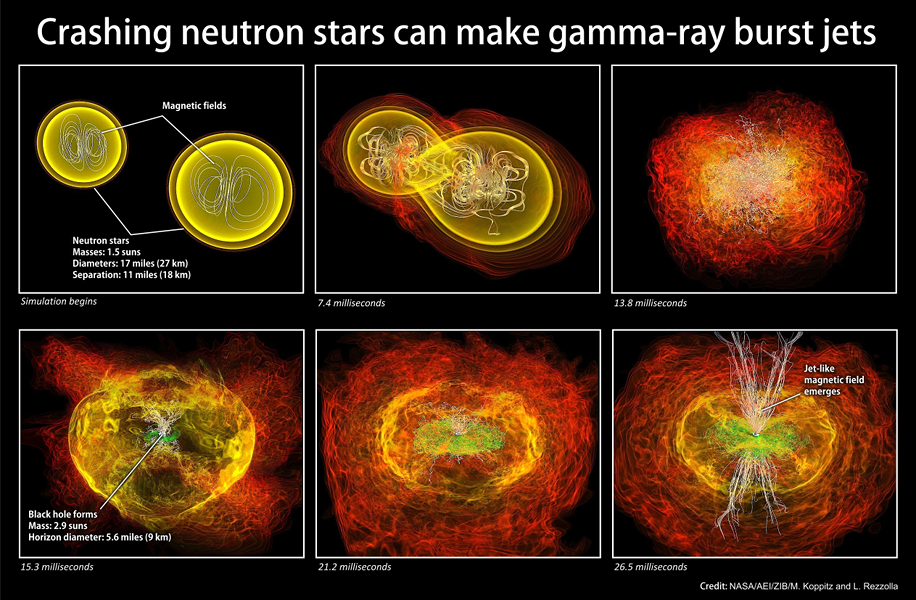
 Credit: NASA/AEI/ZIB/M. Koppitz and L. Rezzolla
Credit: NASA/AEI/ZIB/M. Koppitz and L. Rezzolla
Short Bursts Solved?
Look quick or you might miss it. Fast phenomena are hard to study and harder to understand, a statement that is particularly true at Gamma-ray energies. The origin of bright bursts of Gamma-rays have puzzled astronomers for decades. Thanks to studies of afterglows observed by BeppoSAX, Swift, Hubble and other telescopes in space and on the ground, we now know that a subset of these bursts originate from the deaths of extremely massive stars. But another subset of Gamma-ray bursts are extremely short, and they still puzzle astronomers to this day. A popular model describes these "short GRBs" as the result of the catastrophic explosive merger of two neutron stars in a binary system. This model is plausible since we already have seen neutron star binaries in which the two neutron stars are, in fact, in a death spiral. But in general Gamma-ray bursts are believed to require some mechanism to collimate the gamma-rays produced by the explosion into jets of particles beaming out into space. So a puzzle remains: how can a neutron star merger result in a collimated beam of gamma-rays? A new supercomputer model of a neutron star merging with another may have found the answer. This new model, shown figuratively above, is the best computational description of the neutron star binary merger process ever built. This simulation showed that when the two neutron stars collided with each other they are transformed into a rapidly spinning black hole. Barely 11 milliseconds after the merger, gas swirling close to the speed of light continues to amplify the already strong magnetic field of the neutron stars. But the surprise was at the end, when the simulation shows that the chaotic magnetic field somehow organizes itself and gradually formed a pair of outwardly directed funnels, or proto-jets, on either side of the baby black hole. Interesting and plausible - but confirmation of this model will have to await the detection of gravitational radiation produced by the merger.
Published: April 18, 2011
<
HEA Dictionary ● Archive
● Search HEAPOW
● Other Languages
● HEAPOW on Facebook
● Download all Images
● Education ● HEAD
>

Each week the HEASARC
brings you new, exciting and beautiful images from X-ray and Gamma ray
astronomy. Check back each week and be sure to check out the HEAPOW archive!
Page Author: Dr. Michael F. Corcoran
Last modified Tuesday, 27-Feb-2024 10:15:21 EST


